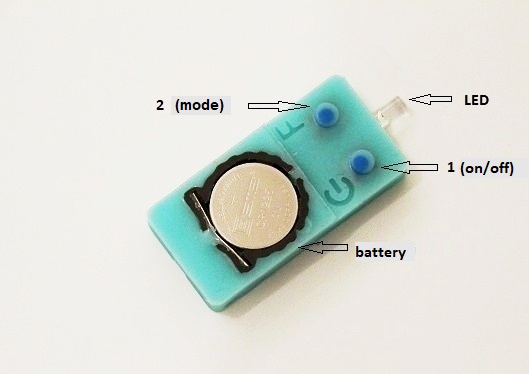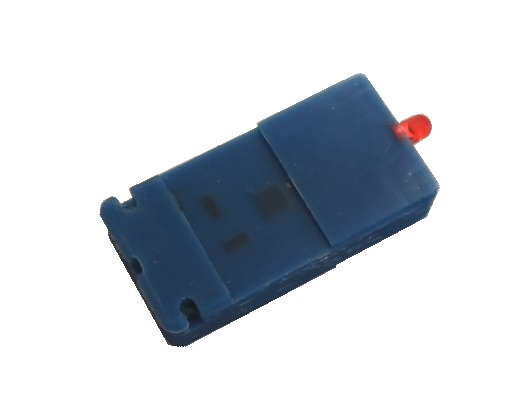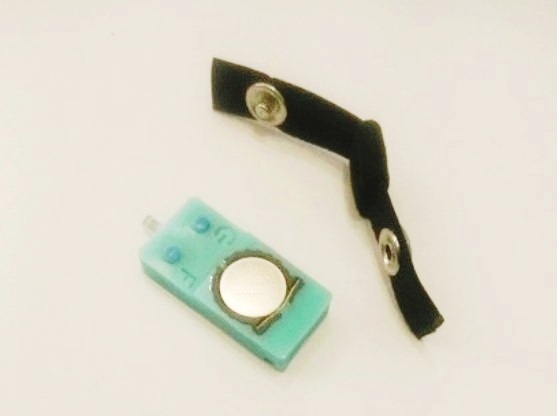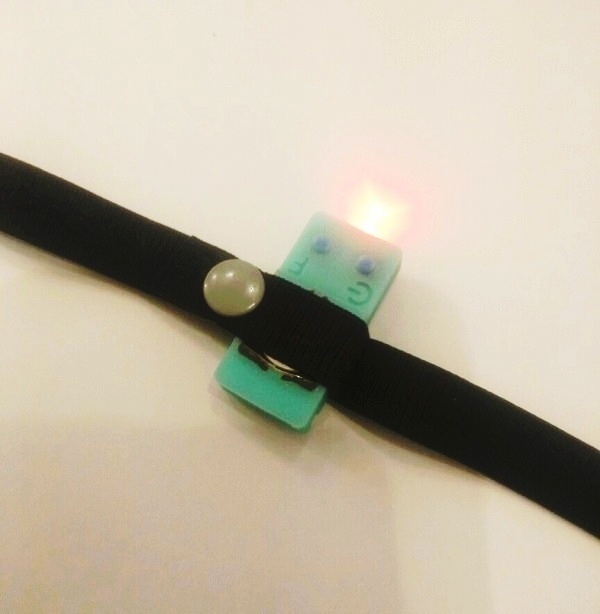Manual for Mind Trainer
Mindfulness Training Device.
"MindTrainer"

Chapter 1. Use of the device
Appointment of the device and scope of application:
The compact, easy-to-use but multi-functional MindTrainer has three main areas of use:
- Training of the mindfulness
- Self programming
- Feedback from the device DreamStalker
1. Training of the mindfulness:
Mindfulness can be defined as a state of self-mindfulness, thanks to which we can act much more meaningfully, do something conscious out of habit, following the emotional reactions.
From the point of view of psychology, awareness is a state in which a person monitors his current experiences, focusing on the present moment, without being distracted by thoughts about the past or future. It represents the ability of consciousness to introspection (internal observation) of its activity. This means that individual experiences are perceived by the person as they are. In most cases, awareness is directed to internal states, for example, to intuition or sensory perception of events occurring in the external world.
According to many researchers of bodily awareness in psychological and energy aspects, at a certain age we get the opportunity to consciously regulate our perceptions of ourselves through our bodies. With the help of self-awareness, we get the opportunity to influence our personality and build our own reality.
Many of you have no idea that your behavior is largely controlled by the reflex reactions of the psyche, based on previously formed beliefs, concepts, views on yourself, people and the world around you.
These mental constructions form a prism through which, as though through a curved mirror, we look at the world in the future, we see not reality as it is, but a projection of this reality distorted by our perception.
The ability to become aware of oneself appears in a person as a result of the ability to separate: self-observer from self-observed, self-separate from the environment. You always act in the usual stereotypical way and then wonder why nothing changes in your life.
Due to the transition to a state of conscious observation, we develop our internal “caretaker”, we have the opportunity to notice something and make another (new) choice, not based on the usual reaction. This is true freedom when a person is the master of his thoughts, emotions and actions. When thoughts, emotions and conditions do not rule them.
The accelerometer (acceleration sensor) of the device responds to acceleration, therefore it is triggered when body movements become choppy, mechanistic, reflex, not conscious. The flashing red light reminds you to realize yourself and take the position of the observer.
2. Self-programming
By self-programming, we mean integration into the subconscious mind of the settings needed to model the desired picture of the world, thinking, and actions.
The established patterns of thinking and actions can be called programs that are formed using repeated thoughts / actions, are acquired by the subconscious and participate in the regulation of the entire psycho-emotional sphere, including health.
We can say that our whole life is the result of the work of attitudes that seem correct or convenient to us, or rather, those behaviors for which the subconscious is programmed seem correct to us.
The deliberate introduction of positive and self-developing attitudes into one’s life can be called “positive self-programming,” unlike many attitudes forcibly introduced from outside, for example, advertising, suggestions from other people, etc.
It has long been known that our brain is responsible for all models of our behavior, as well as for the regulation of psycho-physiological processes, including health.
The patterns of our actions can be called programs that are formed with the participation of repeating thoughts and actions that are acquired by the subconscious, after which our actions and thoughts become template, complementing the existing template picture of the world.
Positive self-programming is one of the ways to build your life in accordance with your own priorities and your values. That is, self-programming is a practical implementation of that life model (picture of the world), which is much more consistent with your life priorities and desires.
Each time the device is triggered and you enter a state of awareness, speak out the affirmation, mentally associating a series of blinks with the installation.
3. Feedback on the DreamStalker
It is known that during sleep, the human consciousness is not active, but the subconscious is active. It is especially active and open in the REM phase. This is the most effective time to introduce positive or developing attitudes into the subconscious. DreamStalker effectively determines the beginning of the REM phase by eye movement and triggers an audio mode in which the text of a positive attitude or an individual affirmation is pronounced. After that, red LEDs begin to flash before the eyes with a certain frequency.
After a series of flashes, the affirmation or positive attitude is repeated again. Thus, the conscious logic of the text of a positive attitude is subconsciously associated with the blinking of LEDs in front of the eyes.
The REM sleep phase can occur several times in one night, and therefore the subconscious mind effectively assimilates the deep essence of affirmation or attitude.
Therefore, the very next day, using the feedback provided by “MindTrainer”, you can feel that the subconscious mind “actively remembers” the new model in the dream at the moment when the feedback LED in front of the eyes starts to flash, but in an awake state.
As a rule, a “daytime” recollection of the subconscious mind of the positive attitudes laid in a dream comes in the wakeful period with the help of feedback. Not in the form of verbal formulations, but in the form of vivid and “inspiring” strong images, which will speak of the active involvement of the subconscious in the processes of changing oneself for the better.
If in a waking state we do not experience the response of the subconscious mind to the settings laid in a dream, then most likely the subconscious mind does not actively participate in the realization of what was conceived, but simply lazy or asleep.
Feedback allows you to remind your subconscious of the processes that occurred in a dream at the time of laying a positive attitude.
Work with DreamStalker
There are many methods of programming yourself in a dream, including the study of foreign languages. It is believed that the subconscious mind should remember the material, but in reality it can be very difficult to remember. Just like it is sometimes difficult to remember your dream.
To do this, use the “MindTrainer”, which provides active feedback with those self-modeling processes that occur in a dream using the DreamStalker.
Thus, DreamStalker, used in conjunction with the “MindTrainer”, becomes a universal device for self-programming in a dream.
Affirmations, positive or developing attitudes can be different and depend on personal needs at the moment. But it’s good when personal affirmations are compiled by professional psychologists or other specialists.
It should also be noted that using the “MindTrainer” as feedback with your subconscious mind should only be done when time and intention are specially allocated for this, so that the subconscious mind understands that our consciousness takes it seriously and does not refuse to cooperate in the future.
The feedback technique is as follows:
By manipulating the Dream Stalker, the affirmations that are currently needed are recorded on the memory card and DreamStalker is set to the appropriate mode so that the blinking frequency of the LEDs matches the blinking frequency of “MindTrainer” as much as possible.
It is recommended to record affirmations in your own voice for maximum efficiency of information acceptance by the subconscious.
In the self-programming mode, it is better not to rush to use feedback, but how to relate the laid positive setting in a dream with the blinking of the diodes. This can take several nights, usually two to five.
And then, when the feedback works qualitatively, you will be pleasantly surprised by the physical sensations of inspiration and fullness of energy, which is the criterion for the activity of the subconscious at the moment.
Chapter 2. Technical description and operating instructions
Design and controls

Figure 1. View of the device
The body of the device is made of silicone rubber. Together with the protruding parts (LED and installed battery), the device has dimensions of 46 x 17 x 6 mm.
There are two control buttons on the device:
The button “1”, marked with a symbol  , is designed to turn on/off the power and select the type of work.
, is designed to turn on/off the power and select the type of work.
The button "2", marked with the symbol "F", is used to select the operating mode (threshold).
There is also a red light-emitting diode LED for blinking during the main operation cycle or to display the current setting (when changing the mode or type of operation).
The battery is installed in the slot at the end of the case.
A recess is provided on the back of the case for installation on an elastic fastening strap with a width of 12 mm (Figure 2).

Figure 2. View of the device from the back
Fixing device
There are two options for mounting the “Mind Trainer” device: on the earpiece and on the headband.
The kit comes with a strap for attaching to the earpiece (figure 3) and a strap for attaching to the head (figure 4). In both versions, the device is clasped by a strap and latched onto a button, which makes it easy to remove and insert the device without much effort.

Figure 3. A strap for attaching to glasses
The strap for attaching to glasses allows you to install the device both horizontally (along the handle) by installing the handle between the strap and the body of the device, and across the handle, threading it into the ring located on this strap and made of the same elastic material.
The first option is suitable for frames with thin arches, the second - with thicker arches. In addition, in this embodiment, the device can be slightly rotated relative to the bow, which allows you to turn the LED inward of the field of view.

Figure 4. A strap for attaching to the forehead
For attachment to the forehead, a strap is shown, as shown in Figure 4, together with the device installed on it. The strap can be adjusted according to the circumference of the head, for which buttons (3 pieces) are used, installed at its ends. With this mount, the device must be placed in the area of the eyebrows so that the LED is facing the field of view.
The mounting options for the device on the glasses are shown in Figure 5. Depending on the glasses used and the type of mounting, the device can be located along the arms, across or have some deviation from them towards the field of view.


Figure 5. Fixing on the glasses
Battery installation
The device is powered by a 1225 type battery with a voltage of 3 V. When installing the battery, the polarity must be strictly observed. The Mind Trainer provides protection against improper battery installation.
In case of improper installation, the device will not be damaged, but the battery will be quickly discharged. Installation must be carried out by turning the battery side “+” to the side of the device, which is marked with the corresponding sign.
Turning on
To turn it on, press the power button (see Figure 1) and hold for about 1-2 seconds.
Switching on the device is indicated by a blinking LED, which indicates the threshold of the acceleration sensor.
It is this type of work that always starts after power is turned on.
Acceleration Sensor (accelerometer) operation
In this type of work, tripping occurs if the selected threshold is exceeded while driving. There are 6 acceleration thresholds in total.
The threshold number is indicated by the number of flashes of the LED from 1 to 6.
To distinguish between the indication of the threshold and the response of the sensor, different flash durations are used.
The activation of the acceleration sensor is always indicated by 3 flashes, with a duration of 0.5 sec and with an interval of 0.75 sec.
The threshold is displayed with a flash, with a duration of about 0.1 sec and with an interval between flashes of 0.4 sec.
Such a difference in the time intervals according to the duration of the flashes makes it always easy to distinguish the state of the device and whether the change in the trigger threshold has occurred.
You can change the trigger mode by double pressing the “F” button (the first is a short press, the second is long with a hold for more than 2 seconds). After the threshold is changed, it is displayed.
If a sensor is triggered simultaneously when the threshold is changed, then this change will be made after the end of the sensor flash cycle. Changing the threshold is always in the direction of its increase. After reaching the 6th threshold, the 1st setting occurs.
The very first threshold corresponds to the highest sensitivity, the last 6th threshold - the lowest sensitivity to movement.
Generate random intervals
You can go into this type of work by double short pressing the power off button. Pressings should be short and follow each other (0.2 - 0.5 sec. Interval between clicks).
After turning on this type of work, the device displays the number of the current maximum time interval. The display is the same as for the acceleration sensor.
Changing the time interval is made by pressing the “F” button once.
In this type of work, the device triggers over a time interval that is randomly selected, but not exceeding the maximum set.
Only 6 maximum durations: 5, 10, 15, 20, 25 and 30 minutes.
The duration of 5 minutes corresponds to the 1st interval, the duration of 30 minutes - the 6th interval.
The device is triggered at a random time interval with 3 flashes, just like when the acceleration sensor is triggered.
Return to the acceleration sensor operation occurs by two short presses of the power button. This will display the sensor trigger mode and the acceleration sensor will start working.
Power off
To turn off the power, press the power button and hold it for 2 seconds. Shutdown is indicated by a series of short flashes (5 flashes lasting 0.04s) - well distinguishable from any others.
To save battery power, the device must always be turned off when working as a generator of random intervals, since in this mode there is a constant count of time and the operation of the device.
When working as an acceleration sensor, there is an automatic battery energy conservation mode in which the device automatically enters standby mode between movements and has a low current consumption.
Contents of delivery
The device comes with a battery installed in it, the straps for it are included. One spare 1225 format battery is included. Package contents are shown in table 1.
Table 1. A complete set of the device.
- "MindTrainer" with installed 1225 type battery - 1 pcs
- Additional 1225 type battery - 1 pcs
- Strap for mounting on the glasses - 1 pcs
- Forehead strap - 1 pcs
- User manual - 1 pcs


